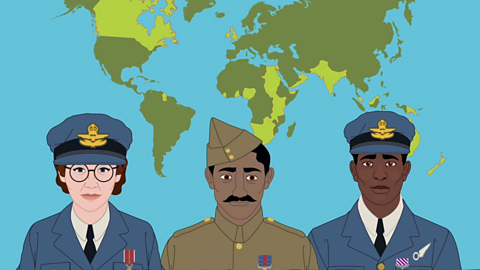Key points
Adolf Hitler became Chancellor of Germany in 1933. He had aggressive and ambitious foreign policy aims.
Britain initially pursued a policy of appeasement, seeking to give Hitler some of what he wanted in order to preserve peace.
When Hitler broke the agreement made at the Munich Conference, it became clear appeasement had failed, and war broke out following the invasion of Poland in September 1939.
Hitler’s foreign policy aims
Hitler had three main aims in his foreign policy:
To unite all German-speaking people.
To achieve LebensraumThe German word for 'living space', used to describe Hitler's aim of expanding Germany by taking land from the east., which was more living space for the German people. This was based on the NaziAn abbreviation for the National Socialist German Workers’ Party (NSDAP) and its members. The term was originally thought up by political opponents of the party. The Nazi Party's main ideas were based on racism, including antisemitism, and hostility towards democracy and other political systems, such as communism and socialism. racist policies, which were rooted in the idea that 'Aryan race'An idea developed in the 1800s, believed by Hitler and the Nazis, that people from northern and western Europe were racially 'superior' to other groups. There is no scientific basis for this idea. people were ‘superior’ to Eastern Europeans.
To destroy the Treaty of Versailles, the peace document that was signed in 1919 following World War One. It placed much of the blame for the events of the war on Germany.
These aims, and carrying them out, was one of the major contributing factors to the outbreak of World War Two in September 1939.
The Rhineland and the Anschluss
Hitler had already broken some terms of the Treaty of Versailles by 1938. He sent soldiers into the Rhineland area of Germany in 1936, which was supposed to be a demilitarisedThe removal of all military forces from an area. area. Britain did nothing, saying that Hitler was ‘marching into his own backyard’. This showed that Britain saw the Rhineland as German land anyway, so they were not too concerned.
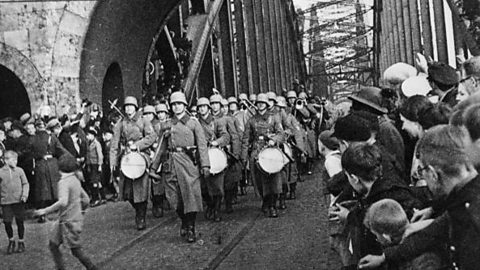
In 1938, Hitler united Germany and Austria. This was known as the AnschlussThe union of Germany and Austria. This was banned by the Treaty of Versailles.. Again, this broke the Treaty of Versailles, but Britain and France did nothing. They saw Austria as a German-speaking country and were not willing to risk war over this.
Appeasement
The British Government, led first by Prime Minister Stanley Baldwin and by Neville Chamberlain from 1937, followed a policy of appeasementGiving someone what they want in order to avoid conflict.. This was a belief that, if Hitler was given some of what he wanted, war could be avoided. There were several reasons for Britain following this policy:
The British people did not want another war so soon after World War One.
Britain had not been rearmingBuilding up a new supply of weapons and military equipment., so was not prepared for war.
Many British Government officials believed that the communist Soviet Union, led by Joseph Stalin, was a greater threat to Britain than Nazism. Britain saw Hitler and Nazi Germany as a barrier against the further spread of communismA system of running a country in which all means of production such as tools, factories and raw materials, are owned by the community as a whole. Private property does not exist and each individual contributes according to their ability and receives according to their needs. This means there is no hierarchy of social class. throughout Europe.
Some people felt the Treaty of Versailles had been too harsh in the terms it imposed on Germany, and that it was reasonable for Hitler to want to reverse some of it.
Britain was still suffering the effects of the Great DepressionA global economic crisis that started in 1929 in the USA. It led to mass unemployment and hardship throughout the 1930s., so did not want to be spending money on preparing for, or fighting, a war.
Video about Chamberlain and appeasement
Narrator: Was appeasement a cowardly policy?
During the 1930s, Germany repeatedly broke the terms of the Versailles Treaty. Hitler rearmed, he reoccupied the Rhineland and united with Austria. And in 1938 he turned his sights on Czechoslovakia. Not until 1939 when he invaded Poland did Britain say, "Stop".
So why did Britain not act earlier?
Britain’s approach to Germany in the ‘30s is known as appeasement. Some people, like Winston Churchill, thought it was a cowardly policy, but was it?
The British Prime Minister from 1937 until 1940 was Neville Chamberlain and he was closely identified with appeasement. Chamberlain was so convinced that he had the right approach, some people found him arrogant.
He certainly tried hard to make it work. He made three trips to Germany by air to negotiate with Hitler over Czechoslovakia. This is how Chamberlain described appeasement.
Neville Chamberlain: "By the exercise of friendliness and understanding of what were the desires of others, to clear up all differences by discussion without armed conflict."
Narrator: Hitler used the threat of armed conflict a number of times to achieve his ends. As part of his plan to take over Czechoslovakia, he threatened to invade one part of it - the Sudetenland, claiming that the German-speaking people living there were being persecuted by the Czech government.
VISNEWS: ‘Since he took office, Mr Chamberlain has never wavered in his determination to establish peace in Europe.’So Chamberlain visited Hitler at his mountain-top residence in Berchtesgaden to cut a deal.
Neville Chamberlain: "In courteous, but perfectly definite terms, Herr Hitler made it plain that he had made up his mind that the Sudeten Germans must have the right of self-determination and declared that rather than wait, he would be prepared to risk a world war. I undertook to return at once to consult with my colleagues. I have no doubt whatever now that my visit alone prevented an invasion for which everything was ready."
Narrator: Chamberlain went back to Hitler a second time, quite confident now that they had an agreement, but Hitler stepped up his demands and threatened war unless he could have the Sudetenland immediately.
In desperation, Britain, France, Germany and Italy met at Munich and agreed to Hitler’s terms. The Czech leader Benes was in Munich too, but Hitler refused to let him enter the conference room.
Later, Benes wrote in his memoirs…
President Benes: "I had sufficient diplomatic experience to see that Europe was hastening to its doom as a result of universal selfishness. Without our participation, the Munich Agreement, fatal for Europe and the whole world, was concluded and signed by the four great powers and then forced upon us."
Narrator: For Benes then, appeasement meant that Britain would avoid getting into a war, whatever the cost to others. But Chamberlain believed that Hitler did have some reasonable demands and he had extracted a promise from Hitler that he would make no more territorial demands in Europe.
CHEERING
But six months later, in March 1939, the Germans annexed the main part of what was left of Czechoslovakia. Hitler had broken his promise to Chamberlain and that same month, Chamberlain changed his policy.
Britain signed a pact promising to protect Poland. This was supposed to send a signal to Hitler that Britain would not accept further German expansion. Britain prepared for war, but Hitler didn’t believe the British would go to war over Poland since they hadn’t stood up to him over Czechoslovakia.
Hitler went ahead with his invasion and Britain declared war on Germany on the 3rd of September, 1939. Appeasement had been abandoned.
The Munich Conference
In September 1938, Germany threatened to invade the Sudetenland, a region of CzechoslovakiaA country that used to exist in eastern Europe. It is now two countries, the Czech Republic and Slovakia. that bordered Germany. Hitler claimed that the 3 million German-speaking people who lived there were being poorly treated by the Czech government.
On 15 September, Neville Chamberlain met Hitler at Berchtesgaden, southern Germany. Hitler assured Chamberlain that the Sudetenland was the last territory that he wanted. Chamberlain believed this, and persuaded the Czechoslovakian leader, Edvard Beneš, to agree to Hitler’s demands.
When they met again at Bad Godesberg, on 22 September, Hitler made further demands, and threatened to declare war if these were not met.
Chamberlain returned home to Britain and made plans for war. Italian leader Benito Mussolini persuaded the leaders of Britain, France and Germany to meet at Munich.
At the Munich Conference, it was agreed that Hitler could occupy the Sudetenland as long as Germany guaranteed they would take no further territory.
Chamberlain returned to Britain and was warmly greeted in London. He famously told waiting crowds that the Munich Agreement had achieved ‘peace in our time’.
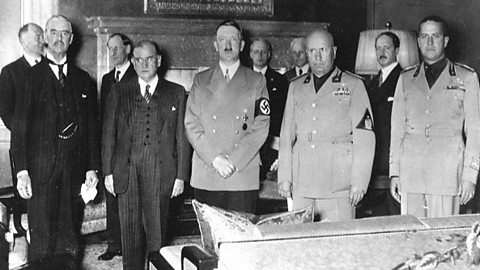
Activity - Munich Conference cartoon
What can you infer from this cartoon?
Key context:
- This cartoon was produced by David Low for a British newspaper, the London Evening Standard.
- It was published on 30 September 1938. This was one day after the Munich Conference had finished.
Some inferences that you could draw from this cartoon could be:
- Stalin is standing in the doorway and not sitting with the other leaders. This suggests that they did not want him to be involved in their discussions. Why might they not have wanted Stalin to be involved?
- The agreement signed by the four leaders has been hidden under Hitler’s chair. This suggests that the leaders did not want Stalin to know about it. Why might the agreement be hidden under Hitler’s chair?
- The cartoon’s caption, ‘what, no chair for me?’, is intended to be spoken by Stalin. This suggests that Stalin was surprised to be left out of the discussions. Would Stalin have expected to be involved in the discussions at the Munich Conference?
- Look at the four leaders sitting down. Hitler and Mussolini have their arms folded, and look determined and aggressive. On the other hand, Chamberlain and Daladier are looking at Stalin anxiously. Why might the four leaders be looking at Stalin in different ways?
The outbreak of war
In March 1939, Hitler broke the agreement made at Munich and invaded the rest of Czechoslovakia. Britain and France were in no position to try and defend them, as Czechoslovakia was quickly conquered. Chamberlain realised that appeasementGiving someone what they want in order to avoid conflict. had failed. He made a guarantee that if Poland was invaded, Britain would go to war to protect them.
A consequence of the Munich Conference was that the Soviet Union, led by Stalin, felt Britain and France were trying to push Hitler east. Hitler hated communism, and Stalin felt threatened by the German advance. To give himself more time to rearm, Stalin signed the Nazi-Soviet Pact with Germany on 23 August 1939. They agreed that they would both invade and share territory in Poland and that they would not go to war with each other.
On 1 September, Hitler invaded Poland. Britain and France said that, if Germany did not leave, they would declare war. Hitler continued with the invasion, not believing that Britain would stick to their commitment to protect Poland. He was taken by surprise on 3 September 1939, when Chamberlain declared war on Germany.
World War Two had begun.
Was appeasement a mistake?
Many people look back at appeasement today and see it as a mistake. However, at the time it was a popular policy. 1938 was just 20 years after the end of World War One. People in Britain were not ready for another major conflict.
Even when it did become clear that Hitler was not keeping to his promises, Britain had not been rearming at the same rate as Germany, so was not prepared for war. Appeasement gave them longer to build up their armed forces.
At the time Chamberlain was pursuing appeasement, Winston Churchill was not in a senior position in the government. He was in the minority in his criticism of appeasement. He thought that Hitler needed to be challenged. It was only after the invasion of Czechoslovakia that people more widely saw appeasement as a failure.
When war broke out, Chamberlain appointed Churchill as First Lord of the Admiralty, the political head of the Royal Navy. Churchill later became Prime Minister.
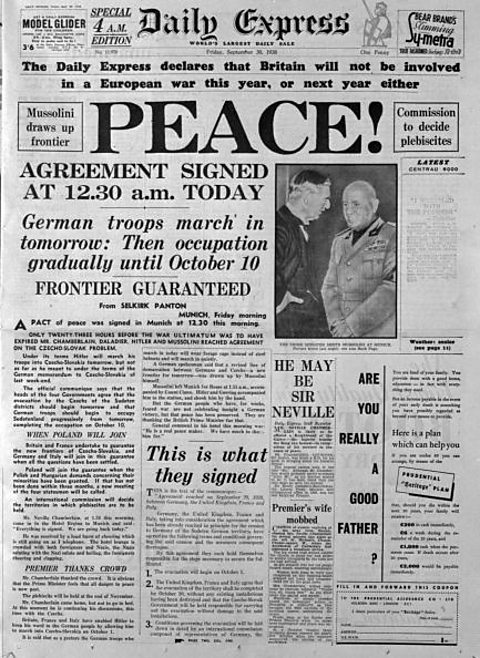
Test your knowledge
Play the History Detectives game! gamePlay the History Detectives game!
Analyse and evaluate evidence to uncover some of history’s burning questions in this game.

More on World War Two and the Holocaust
Find out more by working through a topic
- count2 of 10
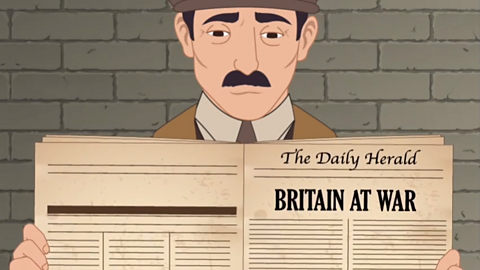
- count3 of 10
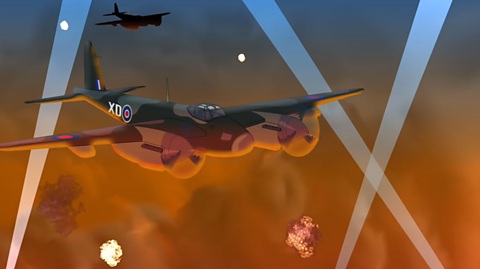
- count4 of 10

- count5 of 10
